#the movie was so fascinating in terms of composition
Text
Still thinking about the musical choices in Rocketman (2019), how they treated it like a musical rather than a biopic with songs like so many normally do. I loved how the songs acted as transitions, and how they underscored the emotion of whatever was happening. The thing i keep coming back to though is how angry and over it “Bennie and the Jets” sounded. Like within the first two chords the anger just flowed, showing the frustration and agitation growing. It was so effective and gave new perspectives on some songs that I grew up with.
#''goodbye yellow brick road'' also keeps coming back to me#because of how they used it like a melodic tool#the movie was so fascinating in terms of composition#both musically and cinematically#ymmv#rocketman 2019#music talk
7 notes
·
View notes
Note
for your recent ask on how to build relationships in movies where you used willabeth as an example i was just thinking of them as i read ur post lmao! what do u think are some underrated aspects of their relationship in the films ? and if you had to pick a favorite film of the potc trilogy based on just willabeth, which would you pick?
Oh, yay! A Willabeth ask!
AWE automatically wins on "At Wit's End" (aka "Will and Elizabeth's love theme") alone. That is the soundtrack to a cosmic, epic, transcendental, soul-moving, earth-shattering love story, that is the epitome of a romantic composition, it is everything. Like just listen.
But I mean, the scenes that they have in this movie?
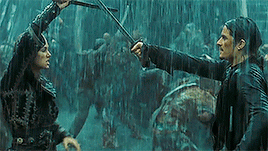



I'm not sure that there's anything that shippers find underrated about them, it would just be in response to Sparrabeth shippers or people who are anti-Willabeth, which I just don't find merits a response but something I do quite enjoy about the Willabeth love story is the role Jack plays in it and how his respective bonds with Will and Elizabeth actually reinforce that love story:
Like, Jack helps Will come to terms with his parentage and history
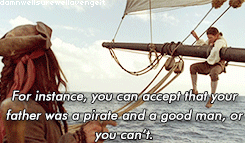
and therefore who he is and Will, in turn, saves Jack from the gallows.
Elizabeth has faith in Jack, tells him he’s a good man, helps him see the morality of situations

and Jack does prove her right in Dead Man’s Chest by coming back to help the crew but I think the most significant way he proves her right is by going against a desire he wanted for all of At World’s End so he can do right by Will (and it actually goes further than his desire throughout At World’s End but to a fundamental passion like he sold his soul to Davy Jones to get the Pearl, that’s how much he loves the sea)

and then you had Jack speaking to Elizabeth’s desire for freedom

and encourages her obtainment of that freedom, of that agency, of that power

which ultimately leads back to her choosing to love and be with Will

which, despite what antis say, isn't a regression. The trilogy begins with seeing her discomfort in "polite society" and feeling pressured into doing what's expected i.e. an engagement to Norrington
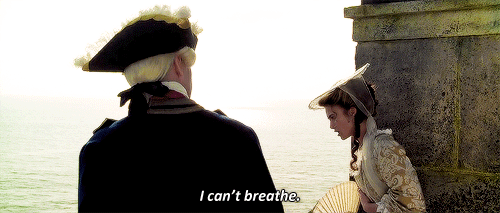
which includes hiding her fascination with pirates as well as her feelings for Will
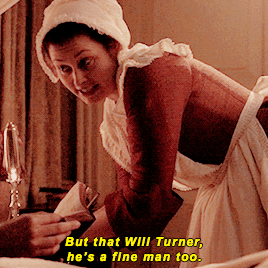

the two things are interconnected. In fact, when we see her being chastised for not behaving the way she should, it's when she's too intimate with Will
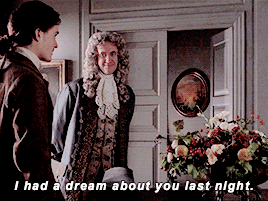

Her interest in pirates is signified with her keeping Will's medallion
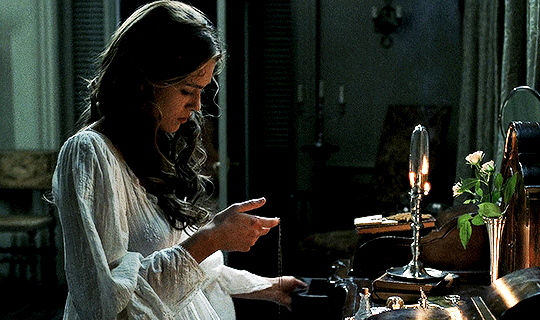
her choosing Will is also her choosing her own freedom
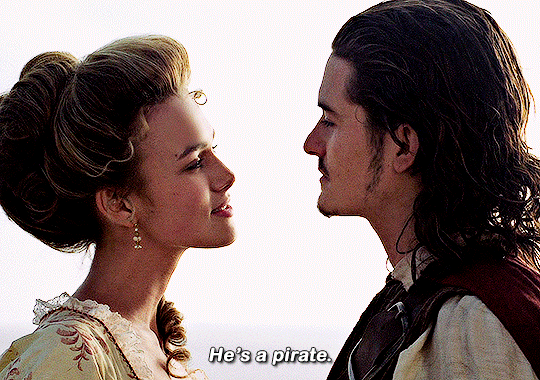
Will even teaches her how to fight
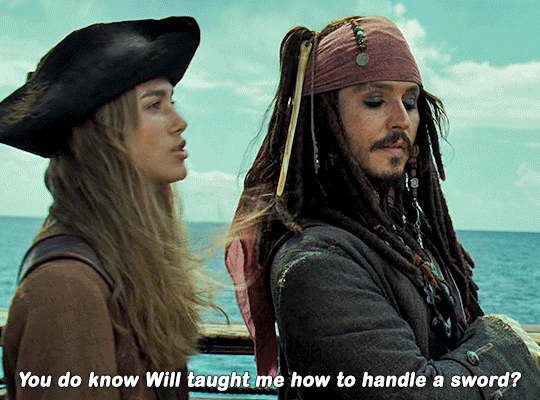
and throughout the trilogy, it's them discovering more facets of themselves i.e. Will reunites with his father, Elizabeth actually gets to be a pirate but what even got them on those journeys was trying to find/help the other so they can be together
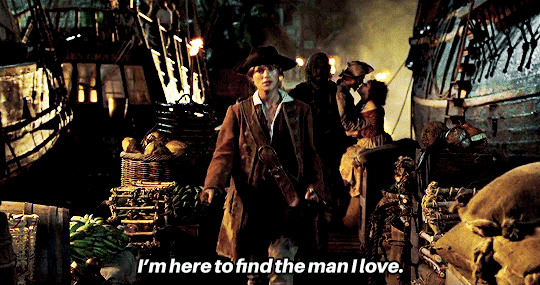

and those layers just bring them back together stronger. This has always been the point
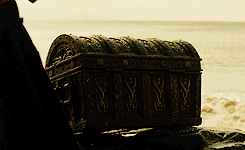
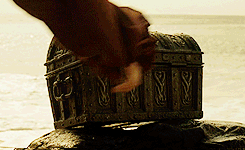


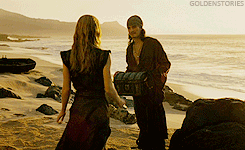

This also isn't exactly underrated but I find when I go into the tag, there's a lot of emphasis on what Will does for Elizabeth, how he supports her, how in love with her he is, how devoted to her he is and I completely understand why but also Elizabeth's devotion to Will deserves a spotlight as well.
Going to fight undead pirates alone to save Will
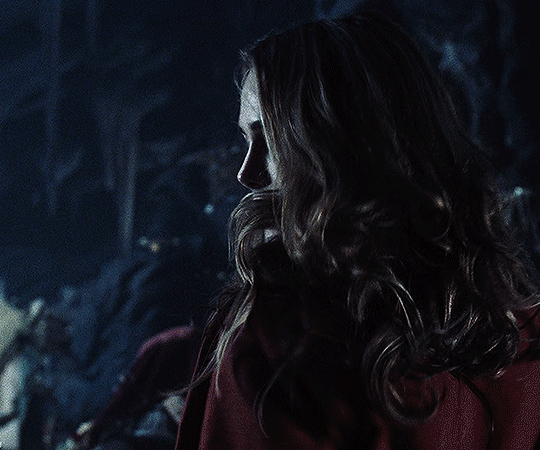
Being both surprised and upset at Will even considering that she could be in love with Jack

Giving away the entire plan because she couldn't feign disinterest when Sao Feng acted as though he'd stab Will

Having to literally be carried away by Jack when Will was stabbed

Even the smaller, in between things like Will shouting at Elizabeth to shoot at the barrels of rum but her refusing because he was still caught in the net.
I just love them so much.
97 notes
·
View notes
Text
nine people i want to get to know better!!
i was tagged by the lovely @clandestinegardenias!! thank you!
Last Song: I-E-A-I-A-I-O by System of a Down! i've been branching out of my heavy metal rut of the last 6 months, but System of a Down still slaps really hard.
Favorite Color: hmmmm i really like lush jewel tones, so i think i have to go with like a deep burgundy right now, but the green of spring vegetation in full sun is a very, very close second
Currently Watching: well. i'm in the middle of a The Terror rewatch right now (again....) but the literal last thing I just watched was the IndyCar Grand Prix in Laguna Seca Raceway in Monterey, CA. but in terms of new shows, i'm not watching new stuff rn.
Last Movie: Mad God. what a fucking trip that film is. jesus. stop-motion horror film. visually gorgeous. disgusting. it was my second time watching it, and it was again really gross and not super linear and 100% up my alley. it was so bizarre, but i am CAPTIVATED by the music (since there is no dialogue; it's only music and sfx) and i want to write a paper on it so so sososo badly.
Currently Reading: currently juggling Captain Crozier: Last Man Standing, Les Miserables, and The Wager! They're all good in their own respects, but very very different from one another, as well. The Crozier bio is a little bit lighter than I was expecting, The Wager more narrative than I was expecting, and Les Mis thus far has just been slow, but i'm in the early pages for everything but the Crozier biography, so i'm still getting used to them. Also I started Persuasion by Jane Austen last month, but haven't gotten very far yet.
Sweet, Spicy, or Savory? they all have their place, but i have such a bad sweet tooth. it trumps almost everything for me. i love sugar.
Relationship: single! i've been single since like.... my sophomore year of high school? and i'm halfway through my master's now, so it's been.... i think i'll have been single for a decade exactly this year, on my birthday. but also i'm extremely aromantic so. that does contribute to that, lmao
Current Obsession: oh it's definitely The Terror. Very much so. but IndyCar is also a quiet sports obsession of mine and i am starting to get In The Weeds for it this year. i deliberately chose to pay more attention after the 500 this year, but i've been meaning to follow the full season for a few years now, and it's been a blast! really nice to watch tbh. it's fascinating stuff, and one of the only sports i can really, truly sink my mental teeth into. also i have been crocheting like mad recently, bc it keeps me entertained and Makes Things!
Last Googled: tire strategy and regulations in IndyCar races, the differences in those regulations between oval and road courses, and the literal difference in composition between alternate and primary tires. very cool stuff. to me, at least, lmao
Currently Working On: jotting down ideas for the next two terror fics i want to work on/sketching out the plots and adaptations for both of them, getting fully trained at my job, and like 3 separate crochet projects. i have. a very scattered brain. also mentally gearing up for my second year of my master's, which is frightening, considering that i have to Write A Thesis soon lmao
oh lordt i don't know if i have 9 people to tag, but i'll tag a few: @imwritesometimes, @jbloopers, @sweetenby, @silkenbutterfly7 - if any of you want to participate, please do!
#trying to be unabashedly into my interests recently so. here we go! unabashed interests of mine#i'm getting just like. unrepentantly into polar exploration history and also indycar. i contain multitudes#but for real this was fun! love this kind of stuff#tag game
10 notes
·
View notes
Text



I have to say I have very much enjoyed my time in this class. I feel like at the start of this semester I was nervous about doing discussions and doing critiques but by the end I had immensely enjoyed looking at classmates' art and presenting my own. And that's all thanks to our wonderful professor, who did nothing but support our discussions and encourage us to get creative with our projects. This class encouraged creativity and outside the box thinking, and the lack of specific requirements was at first nerve racking but I grew to really enjoy the creative freedom of this class. This class exponentially increased my appreciation for art and all the avenues we explored in terms of projects and ideas and theories was fascinating. Especially the archive project, being able to see patterns in the art I enjoy and create that I had never seen before or recognized was fascinating to see. And being able to find more artists and art to include into the archive was so fun, and will be used as inspiration far in my future. I feel this class has taught me a lot about color theory and composition, which is something that will be used constantly in my future art endeavors. My artistic and creative plans specifically are to complete my Bachelors Degree in Fine Arts for Communication Design, which involves taking Art History classes, Fine arts classes like Core 2 and others following that sequence, and Graphic Design classes like Imaging 1 and Typography which I will be taking next semester. I have already completed my core curriculum from my time at Austin Community College, and so being able to focus on only art classes has been a weird adjustment but very refreshing overall, and makes school a lot more fun. I still am taking classes for my minor, which is in Business, but that's nowhere near as fun as these art classes. But I am overall excited for my future here at Texas State, I’m excited to take Printmaking and Metal Working in future semesters, and I'm hoping this will all help me creatively, as I’m not sure what specifically I will be doing out of college, but my achievements will help me tackle any job or project I get assigned; or will allow me to make my own art and express myself how I want to. I think overall the biggest take away I will get from this class is just a newfound appreciation to art of any kind, whether that be paintings, or sketches, or prints, or graffiti, or movies, or books, I just can’t help but appreciate the work that was put into it, and I think it’s such a enjoy to dissect another artists work. Also this class has made me permanently aware of any typography I see on the street or in my daily life now, and aware of all the art that surrounds me each day.
Thank you for the amazing Semester!!
7 notes
·
View notes
Text
The Art of Binge- Watching Embracing the Guilty Pleasures of Online Series Marathons

In the period of streaming services and on-demand content, the formerly- interdicted act of binge-watching has become a famed ritual for numerous. From gripping dramatizations to ridiculous sitcoms, the art of binge-watching has changed the way we consume TV series. In this composition, we'll explore the fascinating world of binge-watching, examining its artistic impact, the psychology behind it, and the shamefaced pleasures that keep us coming back for further.
The Psychology of Binge- Watching Binge- -watching is further than just a lazy Sunday exertion; it's a cerebral trip into the art of lying. The suspensers at the end of occurrences, the flawless transitions from one investiture to the next, and the immersive worlds created by series generators each contribute to a binge-good experience. Psychologically, the expectation and price system touched off by these rudiments keeps observers hooked, creating a sense of instant delectation and escape from reality.
The Rise of the' Bingeable' Series Streaming platforms have subsidized the binge-watching miracle, creating series designed to be devoured in one sitting. The term' bingeable' is now an emblem of honor for generators, indicating Online Movie that their work has the glamorous pull to keep cult fused to their defenses for hours on end. This shift in viewing habits has led to the belle epoque of long-form liars, where narrative bends unfold gradationally, encouraging observers to stay invested in characters and plotlines over multiple occurrences.
The Cultural Shift in Viewing Habits Gone are the days of patiently staying for a week to pass before the coming occasion charade. Binge-watching has revolutionized the way we consume content, creating an artistic shift in viewing habits. Watercooler exchanges have converted into spoiler-filled conversations, and the expression" Have you seen the rearmost occasion?" now carries a sense of urgency. Binge-watching has become a participated experience, connecting observers in a collaborative trip through the twists and turns of their favorite series.
The Shamefaced Pleasures of Binge-Watching While binge-watching is frequently seen as a shamefaced pleasure, it's a shamefaced pleasure with a twist. rather than feeling guilt, observers carouse in the joy of losing themselves Free Movies in a fictional world, temporarily escaping the pressures of diurnal life. The shamefaced pleasure lies not in the act itself but in the indulgence of taking a break from reality to immerse oneself in the characters, conflicts, and judgments that unfold on the screen.

The Dark Side of Binge-Watching As with any indulgence, there is an implicit dark side to binge-watching. The sedentary nature of dragged screen time can have health counteraccusations, and the addicting appeal of binge-good series might lead to neglecting other liabilities. Striking a balance between the pleasures of binge-watching and maintaining a healthy life is pivotal, reminding us that temperance is crucial in all forms of entertainment.
Binge-watching isn't just an artistic miracle; it's a testament to the evolving geography of liars and entertainment consumption. As we embrace the shamefaced pleasures of immersing ourselves in a series marathon, it's essential to appreciate the art behind these narratives while being aware of the impact on our well-being. So, whether you are settling in for a weekend binge or savoring occurrences one at a time, the world of binge-watching invites us to explore the measureless possibilities of liars in the digital age.
0 notes
Note
14 and 19 for the movie questions? :)
ooh! hmm, i don’t think i’ve watched enough movies to have a favorite director. i’ve basically liked everything of taika waititi’s that i’ve watched. i saw fantastic mr fox a few weeks ago and enjoyed it so much that i’ve been procrastinating anything else from wes anderson because i’m sure i won’t like it as much.
for 19, i’m so interested in… camera direction? or maybe a better term would be shot composition. i’m sure there’s a real word to describe what i’m talking about, but i don’t know it. i just like thinking about where the camera is and what we’re seeing, what gets prioritized and what’s left out. i’m mostly very much a literature person in terms of both reading and writing and i’m fascinated by the way a camera lens functions as a narrator.
1 note
·
View note
Text

With the recent controversy surrounding AI art that’s been going on, I’m reminded of a trend I saw within the animation community on YouTube for a while of people raising the frame rates of animations using interpolation. For those less aware, interpolation is a term for using a computer to increase the frames of a video by filling in new frames based on the start and end positions of two frames. So, if an animation goes for 24 frames per second, that animation is stretched out evenly and the computer generates new frames to fill the gaps to make it 60 frames per second. There are a multitude of videos on YouTube where popular scenes from movies have their frame rates artificially created to make the animation look smoother, and a lot of the time they aren’t too great.


I would be amiss to not mention the popular video by the animation YouTuber Noodle, who really does a full deep dive into the flaws that come with interpolation and the misconception that smoother animation automatically looks better; the video itself can be found at the bottom of this post. One aspect I will take from his video is how interpolation often ignores the principles of animation, particularly: Anticipation, Easing, Solid Drawings, Timing, Follow Through, Arcs, and Secondary Actions, over half the principles. The only rules the AI doesn’t ignore are ones that are rooted in character design, scenery, and the most basic movements. Because of how the AI spreads the original frames, rules like Anticipation and Easing, which rely on slowing and holding frames are ruined when the frames all blend together. Other motions such as secondary actions and follow through also get blended, hindering the timing of the motion. Go frame by frame on many of these 60 fps videos (you can do so on YouTube by using the “<” and “>” keys), and you’ll find several times where the character’s bodies morph and disappear unnaturally, most frequently with their faces or hands.

The computer sees the start and end points, but doesn’t know how to get there correctly; it has no concept of human anatomy, weight, or motion outside of the frames it’s being fed. It’s why a lot of AI art can’t get hands right, the algorithm understands the general idea that people have these small appendages at the end of their arms from the art it’s generating off of, but it doesn't know how they exactly bend or how many there are. An AI generator only understands as much as it’s given, so when we run it based on existing frames and various art, it only sees lines, shapes, and colors that it can vaguely recreate. What is upsetting to many artists is how these criticisms of AI art are often hand waved away.

We as artists are currently in a very uncertain period with AI art. Its advancement in itself is interesting in terms of technological growth, it can certainly be used to create fascinating compositions and can work well as a potentially infinite reference source for artists. But, it has also brought a wave of people who are trying to use AI art as a replacement of artist-made art, people who try to pass off AI generated art as their own, and has brought a general fear from some artists of being replaced by AI. This isn’t even going into the fact that these art generators use other people’s work off the internet, often without the artist’s permission, as a base for the art it creates, which itself has created a whole different debate about the ethics of ai art.

With all this discussion still going on and the topic still being relatively fresh, it’s difficult to end a post like this. The most I can give to other artists out there is to continue to pressure your passion. It can feel discouraging to see the rise of AI art for some, but if the lack of detail quality in them, plus how shaky interpolated frames turn out is anything to go by, there’s still a long ways from perfecting these systems, and an algorithm can never replace an artist’s vision.
Noodle's Video:
youtube
0 notes
Text
Hhhh atm I am just…sooo?? fed up with nowadays movies. It’s always lowkey there, but now this feeling is at a max.
They just don‘t feel right anymore. They don‘t give. They feel like cash grabs instead sometimes. Especially now in the franchise recycling era of hollywood. It’s hard to describe. And it’s already a topic in social media, so it’s a mass of people that are like NOPE. So I know that most of the stuff I am talking about was already mentioned somewhere, like the massive green screen use in marvel movies. I just want to rant for a bit.
Big thing that is talked about is lack of practical VFX (def more practical VFX again pleeeasee), but have you listened to the soundtrack of nowadays movies? Remember themes like from indiana jones, lord of the rings or the sixth sense? Because most of what is produced now is a homogenous thing. And most of isn’t even done through an orchestra anymore. It just sounds off.
For example thriller movies. In the 90s they used a lot of classic orchestra composition that added to the plot, gave a feeling to it and had a theme to it?? Can’t watch thrillers from nowadays, because what you hear is a lot of Hans zimmer-esque brutal bass with somewhat digital sounds. And it all sounds the same, somewhat procedural. And guess what: how is a soundtrack supposed to add to the plot when there is barely one. That’s the other thing: thrillers from now feel empty. It’s alot of splatter and adrenaline. But not real thinking, contemplating and conjecturing for the viewers behind it. Thrillers aren’t really thrillers anymore, but border on horror/splatter movies in a way.
But it’s not just thrillers, that was just one example. When was the last time you saw a wholesome movie production in the last years? Close to zero. It’s like a drought. I enjoy me some cheesy movies that I can just let „rain“ over me w/o putting any emotions into it. Just the wholesomeness of it all. But it’s not the only kind of genre that is going through a drought. It’s what friends of mine observed too. Most released movies go into the more adrenalin/action genre way.
Nowadays they only go just „one way“, not even trying to be anything more. Movies like The Mummy were successful because they were able to combine several genres. This whole movie had its own type of personality and that is why it’s so cherished to this day. Another example was 90s addams family movies or legally blonde. Nowadays movies feel like they don’t have any ideas anymore, so they only try to recreate what was successful before for the fast cash grab. Some movies still do have that personality thing and succeed, i.e. like EEAAO, but it’s rare.
And most movies don’t even try anymore because it feels like they let VFX do the talking. People are like uuuh and ahhh about it. But the fascination only holds for so long until there’s the point when all you remember about the movie is the prettiness, but close to no plot. I.e. when you compare movies from the 40s until now you’ll notice that somewhere from let’s say 2005 to 2022 there a „plot decline“ if it comes to summarizing. It’s hard to describe and I know that there is a term for it. It’s the same phenomenon that video games underwent. In short: there’s so much going on in peoples allday life nowadays that the attention span shortened but therefore cognitive abilities increased, so the industry adapted to that lifestyle. In other words: it has to entertain the customer that it’s worth their money, but in a short time span so they can still be „productive“ and/or needs less headspace (i.e. heavy, complex plot) so it’s not energy draining. It’s a complex topic, so I won‘t go into it that much. It really would explain the fascination for marvel movies. It’s like they don’t pay for a movie, they pay for an 2-3 hours event. It’s pretty pictures with lot of action with juuust enough plot. They leave with a rush without being too overwhelmed. And chances are high that you watch them only once for awhile.
And here’s another thing: I don’t need movies to be HD. I don’t need to see pores and wrinkles in every detail. I actually miss the grainy quality sometimes.
Yea I know I sound like a grumpy granny always using „back then“ and „nowadays“ stuff. And maybe it really is a bigger sentiment for nostalgia that I have atm. Though I do know I am not the only one feeling like this and you know that’s kinda sad. Things like movies or in general speaking art and other entertainment is fuel for people to keep them content and it’s kinda frustrating to see one form of content to stagnate in such a way. We do see technical progress in movies and hey that’s great that we can do nifty stuff like that with computers, but what’s the point if more important ingrediens are lacking?
66 notes
·
View notes
Photo


The Red King and his Army (as far as I was aware last week). Basically that sketch there in pencil magically appeared in my sketchbook and I was like, “ya know, that’s actually a pretty good sketch, I could totally make it into a legitimate drawing,” and so, then, I did. It took 2 days, a movie, a stream replay and a few episodes of Criminal Minds (about 6 hours, maybe more???), but it’s done. I’m enjoying Ren’s Red King arc that he’s got goin’ on, I’ve never really pictured him in such a role as being the Red King but it’s really fun to watch. It’s also really fun to see his dynamic with Martyn, and to see how he’s managed to rally people around him (and make enemies of people) on the 3rd Life server. I’m fascinated to see what’s going to go down (well, went down since they already recorded) this week, but I’ve really enjoyed watching the chaos go down. Anyways, in terms of art reflection, I’m going to touch on the fact that this lighting is something I don’t think I’ve attempted in a while, and not in quite this manner. I think the last time I attempted lighting like this was probably a little over a year ago, if not more, but I can’t remember it being as successful as it was here. I also like the intensity of the composition, which is something I haven’t really attempted in this manner in a long time either. But I also really enjoyed drawing the outfits that they’re all wearing. Joel’s I didn’t have to change that much, because it already fits the vibe well, but I made some more serious design adjustments to everyone else because their outfits were more “modern” and less “adventuring clothes”. I also wanted to see if I could tailor each outfit to each person’s skill set/ main weapon/ general theme, for example Skizz wearing armbands and a chestpiece that are meant to resemble what actual archers wear (not sure how entirely accurate it is but I took some liberties in terms of design). Oh, and I brought back Ren’s ponytail because, if he’s going to be a menacing and terrifying Red King that strikes fear into the hearts of those who see him, he certainly must have his ponytail back. But yeah, this was a lot of fun to work on, I really enjoyed drawing this and I hope y’all like it!!
#3rd life smp#3rd life fanart#3rd life#rendog#rendog fanart#inthelittlewood#inthelittlewood fanart#smallishbeans#smallishbeans fanart#skizzleman#skizzleman fanart#ethoslab#ethoslab fanart#digital art#drawing#digital drawing#my art#this was way too fun to draw
599 notes
·
View notes
Text
The Chronicles of Narnia movies are better than the books and that’s a fact. I’m joking. It’s not a fact, it’s an opinion. Now, I have read the books and I have watched the most recent movies, so I feel like I do have a sliver of credibility.
I will acknowledge that I watched the movies first, so I do have a bias as they produce a sense of nostalgia. However, I’m trying to weigh both sides, as I generally prefer book versions of stories over movie versions.
C.S. Lewis wrote these books more than fifty years ago, so it would make sense that the writing style is quite different. He uses different lingo and uses outdated terms/references. However, I’m just not the biggest fan of it all.
He’ll fill up an entire page of just one long paragraph that explains the setting. I absolutely abhor long paragraphs and long descriptions, so this would be a double negative for me. He spends a while discussing lore, which is fascinating, but sometimes it’s a little too much.
While I dislike the overall composition, I do like how Lewis writes perspectives. He tends to use third person omniscient to explore the characters’ thoughts and feelings, which I like, but I also like his narration because it feels like he truly is a storyteller.
He also doesn’t bother with scenes that he considers unnecessary, which feels like a double-edged sword. Conversations that recount stuff that we already know are cut out, which is nice, but he also keeps the battles too short. in my opinion. I just don’t like his pacing, with loads of exposition at the beginning, the journey takes most of the book, the climax is very short, and there’s barely any story left for exposition.
The movies I feel are better because they show the beauty of Narnia without having to spend oodles of time on it. They show lushness. They show whimsy. They show magic. It truly feels amazing, especially with the scores that they play. The music that plays when Lucy first arrives in Narnia is, in fact, iconic to me. The pacing is also better for me because the exposition isn’t too long, the rising action is full and tense, the climax isn’t too short, the falling action exists, and the resolution feels earned. I don’t know, these are just my opinions.
It has been noted that the characterization of the Pevensies were a little skewed in the movies. Peter was still mature, but he was also bolder and more passionate, particularly in the second movie (but it can be argued that his anger was because of trauma and trauma tends to change people). Susan was less angry and more patient. Many have argued that they switched Susan and Peters’ personalities in the movies.
Edmund, Lucy, and Eustace are more-or-less the same, but I would argue that Lucy was more prone to frustration in the books (I’m thinking of that time at the end of LWW when she was waiting for Edmund’s wound to heal, but Aslan told her to tend to other soldiers and she got testy). Caspian is less impulsive and more thoughtful (that scene in VOTDT where they were in the golden cave and Edmund was the one who was more affected by the curse, rather than how it was Caspian in the book).
I think that the characterization is better in the movies because like I said, Lewis relies heavily on plot and lore. His characters aren’t as distinct as they are in the movies. In my opinion, the Pevensies are quite bland in the books.
Peter is one that is bright and bold and in-your-face and magnificent. Susan is beautiful and smart and flawed and awesome (have I mentioned how I love that the girls get to fight more in the movies). Edmund is passionate and loving and wise. Lucy is charming and adorable and smart in her own way.
I also love how the movies portray a believable family. They fight and they bicker, and they play, and they joke; they feel like real siblings. To me, in the books, they felt like mere casual friends. In conclusion, while I am reluctantly fond of the books and can understand why they are so loved, I prefer the movies.
#peter pevensie#susan pevensie#edmund pevensie#lucy pevensie#the chronicles of narnia#c.s. lewis#is the chronicles of narnia books better than the movies#my post
20 notes
·
View notes
Text
E2 artworks are for the most part delightful, but today, I would like us to pay particular attention to certain characters’ Elite 2 artwork: Nightingale, Cuora, and Specter.
The three of them have two things in common: The first is that they are all amnesiac (or, in the case of Nightingale, partially amnesiac, but amnesiac nonetheless), the second is that they are all drawn by Skade. I think the Hypergryph writers just have an Amnesiac Hotline for whenever they conceive another amnesiac character and it connects directly to Skade’s temporal lobe, where all information about the new character is immediately uploaded to and then he just starts furiously drawing.
But let’s focus on the fact that they are amnesiac in this post, and how this is reflected in their E2 art in a way I found clever. Let’s begin with our favorite fashionable demon, Nightingale.

Nightingale’s name is a two-fold allusion: The most evident one is being an homage to Florence Nightingale, the mother of modern nursing. The other, perhaps least apparent but of equal importance, is to the Greek aesop “The Laborer & The Nightingale”, which tells the tale of a poor laborer who, enthralled with the beautiful song of a nightingale that sang every day atop a tall cedar tree, grew selfish and built a cage of iron and twigs to capture the nightingale to make its songs his and only his. Her lines make several allusions to cages and empty rooms,


and of only being let out of her ‘cage’ when someone needed her healing powers, her “song”, if you will (especially relevant when you consider how song and Arts seem to be related in Terra). Her E2 art, thus, represents her bursting out of her cage or iron and twigs. Unlike other Sarkaz Operators, her E2 is not a shape or a representation of a Demon, it is, instead, a representation of her inner Demon, the cage of her head, which contains all of her memories and emotions locked tight within in. She’s not there yet, but she’s making progress. It is worthy of note that Shining also doesn’t depict a Demon in her E2 art, her artwork instead centering on her shield, but while Shining’s E2 art is an allusion of her deep, deep shame of being a Sarkaz and the things she’s done as a Sarkaz (or, in other words, denouncing her own identity to focus on what she truly wants to do from here on, which is to protect others), Nightingale’s E2 artwork instead depicts her destroying part of the cage that holds her back: She’s not fully out yet, but now, it is only a matter of time.
Then, what about Cuora?

Some Operators show a manifestation of their identifying animal that might not be entirely physical but it’s clear, with hard colors and textures. Other Operators show their animal very clearly, as if it was truly there, like Perfumer and Siege, and in some cases, it REALLY is there, as with Eyjafjalla (who directly addresses them in a voice line), and this seems to be matter of artistic preference, but whereas Skade normally draws E2 manifestations with solid colors, in the case of Cuora and Specter, he chooses to make them almost phantasmal, with soft colors and an ephemeral feel to them instead. In fact, the turtle you can see above is as generic as can be, it doesn’t seem to be identifying of any particular turtle species, and all we know about it is that it is “a turtle”. This is deliberate, meant to represent Cuora’s amnesia: Her race, Petram, is not unknown, but she doesn’t remember what specific kind of Petram she is. There’s a lot of turtle species, so which one is she? We have no idea. We know Blue Poison is a Poison Dart Frog, we know Nearl is a Pegasus, so when it comes to species either real or fantastic, we usually have an accurate account of which each Operator is supposed to represent, but not with Cuora, because she’s amnesiac. Whatever specific kind of Petram she is, we’ll never know unless someone that can properly identify her or that knew her from before the amnesia can divulge that information. To represent this, thus, her animal manifestation is ephemeral, phantasmal, ambiguous: It shows us exactly as much as we know of it, that is, that she’s a turtle, nothing less, nothing more.
So where does this leave Specter?

Nightingale has partial amnesia, Cuora is amnesiac but her Oripathy was caught in time and she’s been stabilized, but Specter’s nervous system has been ravaged, and not only is she amnesiac, she’s also prone to bouts of insanity and of sometimes saying some rather concerning things, such as wanting to take Doctor to the “place where secrets are imparted” or how “some people were never ever meant to be one, so it is her duty to cut them into many”.
Nightingale’s art, if you look above, is ‘solid’, bereft of particles or separated parts: It’s an iron cage, the twigs, and herself. Cuora’s art is somewhat more ‘loose’, with some weaving loose lines on the lower part of the drawing to presumably represent low tide, where you would normally find small turtles, as well as to represent her somewhat deteriorated but overall well-preserved psyche. Specter’s art, in contrast, is very loose: There’s an emphasis on aquatic trails all over the composition, representing the deep sea, as well as her flowing cloak, hair, and habit flaps. There’s many loose ‘particles’, like smudges of splattered ink, representative of her shattered psyche, and, most importantly, there’s not one but two sharks of different species as her animal representation. I believe they are representative of how she’s currently ‘two’ people: The somewhat manic but otherwise harmless Specter that can be found roaming the halls of Rhodes Islands’ dorms, and the completely silent fighting machine named Specter that can be found roaming the battlefield like a vengeful ghoul, following orders to the letter, her own safety be damned.
But there’s another meaning, I believe: Cuora at least has one turtle in her art, which can at least let us approximate which species it could possibly be (likely a freshwater turtle judging from comparative size and shell shape, bigger than tortoises, smaller than sea turtles), but Specter has two sharks, which means properly approximating her exact species becomes a lot harder. Skadi and Deepcolor, fellow AEgirians, make it very clear which animals they are supposed to be (Orca and Dumbo Squid, respectively), which further proves that this is a Specter-specific conundrum and not a Deep Sea trait. Likewise, her outfit has several allusions to the overall shape of a shark, but not to any specific shark.
If we want to dig deeper, and boy howdy I bet we do, we can take a look at the Chinese Hanzi that composes her name:



“幽灵鲨”, or “Yōulíng shā”, which translates literally to “Ghost Shark” from Chinese to English. Fitting that her codename is given as Specter. So, what’s a “Ghost Shark”, exactly? Aside, from, you know,
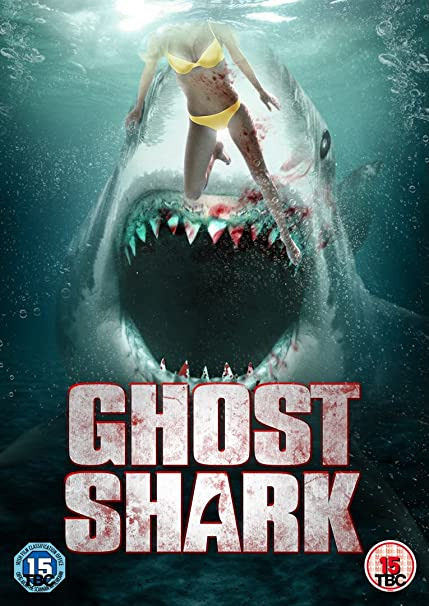
a really bad B-Movie.
Sounds like it’s just a cool poetic name for someone who is but a specter: a fleeting existence, with no memories, only a shadow of her former self, no?
Well, that works out, to be frank, but it turns out, Ghost Sharks are a real species. This is the Bahamas Ghost Shark:

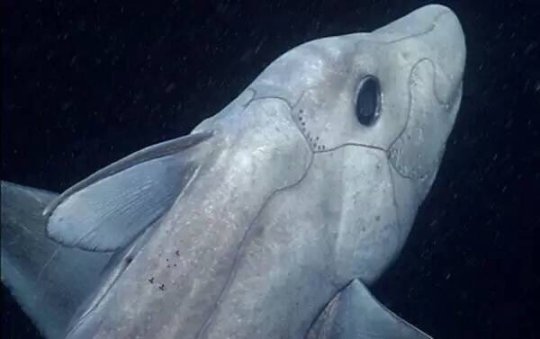
And this is the Australian Ghost Shark:
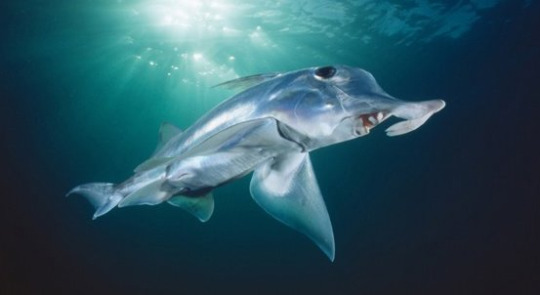
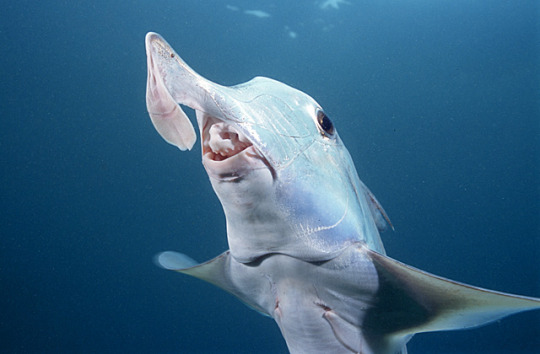
They belong to a species of fish known as Chimaeras, and they live in temperate ocean floors down to 2,600 m (8,500 ft) deep and are some of the oldest fish alive, they share plenty of characteristics with their prehistoric ancestors (or, to translate this to Arknights terms: keep in mind how Specter looks just like a regular human). These are deep sea fish, with only a couple of them coming close to the surface rarely, and it fits with what we know of Specter, what with her background of fighting giant Deep Sea monsters as an Abyssal Hunter. Of course, whether she is supposed to be a Chimaera of any sort remains to be seen, but it wouldn’t surprise me if she was, given the thematic similarities.
I found all of these little nudges and nods to be plenty fascinating. Am I perhaps reading too deep into this? Always within the realm of possibility! Are Skade and Hypergryph planting seeds of lore that will bloom much later, making every piece of evidence given until that point suddenly make cohesive sense? Wouldn’t put it past them! So analyze, analyze, and analyze, because even if it takes you nowhere, lord knows it’s fun to do so.
361 notes
·
View notes
Note
clari, question for you-ABOUT you! Does anything in production stand out to you when watching movies? like i know for me i love some good sound design so when a movie has some AMAZING sound effects it gets me hyped (like War of the Worlds Tripod sound). is there anything like that for you? also ily lots and lots, have a wonderful day 💖💖💖
about me!? :o may!!! OOOOOOOOOOOOH THIS IS A FANTASTIC QUESTION HEHEHE god i could talk about film forever fr aaah <333 in terms of production, i’m a huge whore for cinematography + set design (waaah tbh mise-en-scene as a whole hehehe but i knooow that’s cheating). i’m forever fascinated with how much camera movements, angles, dof, lenses, and framing + composition can affect a viewer and how they derive meaning from a particular shot, scene, or film. i’ve written at length on this for several different films, because it’s just SO interesting to me. there’s so much you can convey emotionally through cinematography alone!!! and then with set design, it’s the same thing (a set can tell us SO much about a character/story!!!) but i also just really love aesthetically pleasing things (aka i like to look at pretty stuff) (*/ω\*)
also, both my boyfriend and my favourite prof are super super into sound design eeeee
#in school (and as defined by david bordwell) mise en scene = lighting; staging; costume and make up; and set/setting#there are a lot of articles floating around online that define mise en scene as like ten things that are just subcategories of those four#lmao#but that's what i was taught in school!!!!!#ANYWAY I'LL STOP WITH THAT NOW#just for anyone who isn’t quite sure what it is!!!#that’s so interesting tho omg i love that u love sound!!!!!#sound is really neat#foley artists are amazing#like sound is my fave prof’s area of expertise and it’s just aaaah REALLY INTERESTING#i feel like many people don’t realize just how much SOUND impacts us as the viewer!!!! ESPECIALLY IN HORROR OOOOOH#may ilysm i already told u this this morning but i hope u have a fantastic weekend <33333#as always stay safe n healthy pls!!!!#amayzing#clari gets mail
6 notes
·
View notes
Text
The Mars Volta - Amputechture (2006) 15 year retrospective

This week marks the 15th anniversary of The Mars Volta's third LP, Amputechture. In time to celebrate, German label Clouds Hill teamed up with the band to remaster and re-release the album on vinyl, first as part of an epic 18-disc box set released earlier this year, and then as an individual release this month.
The follow-up to their seminal Frances the Mute, Amputechture sees the band explore even more experimental territory than its predecessors. Superficially, the group has frequently drawn comparisons to Led Zeppelin, Rush, Yes, Santana or even contemporaries like Coheed & Cambria, but anyone with half an ear can tell you there's something more to their sound than the dusty old prog LPs in your dad's garage.
The songs on Amputechture may each be student-film length, but they are modern, instantaneous, plaintive, combustive. Guitarist Omar Rodriguez-Lopez cites salsa virtuosos like Larry Harlow and Charlie Palmieri; hardcore acts like Black Flag and Bad Brains; and the films of Werner Herzog and Fellini as bigger influences than the stuffier sounds of the 70s rock canon. If anything, they channel the more experimental fusion stylings of King Crimson and Mahavishnu Orchestra through their unstable, Latin-tinged take on progressive post-hardcore into this juggernaut of a record.
Some, like me, consider it a testament to the maturity of their compositional abilities. Some, like the self-appointed taste-making dickheads at Pitchfork, considered it wildly self-indulgent. While reception proved somewhat divisive in the day, the overall reception was typically positive, if bewildered.
It's no secret to anyone who knows me that I'm a die-hard fan, so I'll dispense any pretense that I could ever do an objective critical review. There are dozens of them out there, so when I talk about music, I prefer to cover what fascinates me personally about it rather than attempt to synthesize what another listener might take away from it. Amputechture, long considered by the group to be their "misunderstood, autistic child," is in fact my favorite record of theirs, and perhaps my favorite record of all-time.
That's not to say that I would recommend it to just anyone. Even a lot of fans of their first two records found this at-times cacophonous melee of a record to be a bridge too far, and I can understand. Maybe it was a time-and-place kind of thing, but to me their music always sounded closest to the actual chaos swirling in my angsty young adult brain. Their Rick Rubin-produced first album was by far their most palatable outing; their second was a band able to introduce themselves on their own terms; but Amputechture was for those who had already bought in entirely and were ready to take the next step with them. And I certainly was.
Where their first two records were ostensibly narrative concepts -- the first, a hallucinatory sci-fi adventure in the mind of a comatose man; the second, an adopted man trying to uncover the horrifying secret of his birth family -- singer Cedric Bixler-Zavala wanted to take a different conceptual approach this time around. Instead of a unifying narrative, he wanted to invoke tv shows like Rod Serling's Night Gallery or movies like P.T. Anderson's Magnolia, where individual narratives (as represented by each of the eight songs) shared a common, connective thematic thread.
The band has often cited film as not only a primary influence, but also as a feeling they're trying to recreate. They certainly succeed in that -- Amputechture's cinematic pacing is undeniable. Songs and individual movements within play out like scenes in a movie, each with their own building tensions and climaxes. Intro song Vicarious Atonement is the Crypt Keeper telling you what's in store for tonight. Songs like "Tetragrammaton" and "Day of the Baphomets" feel like they could end multiple times before they explode back into action.
It all feels like meticulously-controlled chaos, bombastic as possible yet textural and layered. Even "Viscera Eyes," which features their most point-blank, RATM-channeling pentatonic riff, bisects into a vulnerable, soaring outro coda. Listening to Amputechture isn't unlike watching a David Lynch film by yourself at 3 am with the lights off. It's unsettling, at times beautiful, abstract but always fascinating.
While it never climbed the heights of critical or commercial success that its two predecessors did, I'll always revere this bizarre, jagged, "autistic child" of a record as my personal favorite album from one of the most respectable and daring discographies in modern rock history.
Amputechture is available for purchase on vinyl directly from the label at the link below, and on all major streaming platforms.
https://us.cloudshillshop.com/products/the-mars-volta-amputechture-2lp
#The Mars Volta#Amputechture#music on vinyl#Clouds Hill#progressive rock#at the drive in#alternative rock
6 notes
·
View notes
Text
What are the costs of dental veneers in Somerset, NJ?
If you wish to wear a smile like your favorite celebrity or movie star, it could be possible with Dental Veneers. They are popular dental procedure that has played a great role making many people’s lives more enjoyable. They are mostly part of smile makeovers and various other cases that focus on improving a person’s teeth and smile.

It is natural thing that a person’s self-esteem and confidence has a solid relation on how a person sees himself as an individual and with cosmetic veneers, a lot of people will surely be confident enough to realize that they are definitely as valuable as others.
What are dental veneers/laminates?
Dental veneers are made of either porcelain or composite resin material. Most cosmetic dentists recommend porcelain material and consider it can mirror the exact shining properties of natural teeth as well as resist staining. Besides, it can cover the underlying tooth color entirely. On contrary, resin material has a tendency of getting stained in the long term.
Dental laminates and veneers are almost same technique. They are customized to match the natural color and shape of teeth. They are designed in lab and bonded on the outer surfaces of prepared natural teeth to correct their color, shape, size, or appearance. You can book an appointment with Smile Designs 101 to know more.
What are veneers costs in Somerset?
Veneers are the best solutions for dental problems such as severely discolored teeth, tooth fracture, crooked teeth, teeth gaps, worn out, and abnormally shaped teeth. The treatment is normally completed within three dental visits. Though most people understand the role of veneers as they are used in enhancing the look of a patient’s smile, they are not much fascinated about the expenses for such a treatment.
Dental veneers can be a costly deal for many. A single-tooth veneer can cost anywhere between 900–2500 USD, in Somerset. If you live in this location, it would be best if you Contact- Smile Designs 101. They will thoroughly examine your dental condition to precisely determine which treatment will be right for you.
Dental Veneers will definitely help a person achieve the coveted look and get hold of the most elusive confidence that kept a person enjoying the opportunities that come along. Knowing the costs in advance is important so that you can be confident if you would be able to pay for the desired treatment.
#dentalclinic#teethcare#dentist#SomersetVeneers#bestdentistinny#SomersetVeneerstreatmentinsomersetny#bestsomersetdentist
1 note
·
View note
Text
Michael in the Mainstream: The Chris Columbus Harry Potter Films

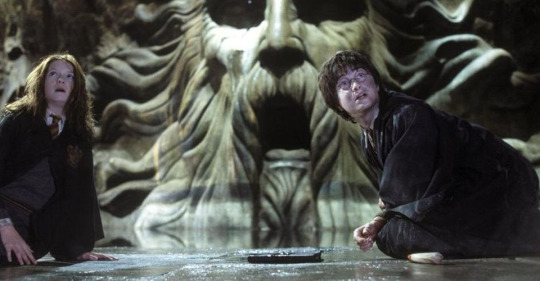
Here’s a bold stance to take these days: I actually still really love the Harry Potter franchise.
Yes, this series hasn’t had a huge impact on my own writing; my stories I’m working on draw far more from JoJo’s Bizarre Adventure and the Percy Jackson series than they do Harry Potter. And yes, the author of the franchise has outed herself as a transphobic scumbag whose every post-script addition to her franchise has been an unprecedented bad move (save, perhaps, for allowing Johnny Depp the opportunity to work during a very trying time in his life). But while the author is a horrendous person and the story hasn’t exactly given me as much to work with as other stories have, there are so many great themes, ideas, and characters that even now I’d still say this is one of my favorite series of all time. The world of Harry Potter is just so fascinating, the usage of folklore is interesting, and it has one of the most menacing and disturbing villains in young adult literature and manages to play the whole “love prevails over evil” cliché in such a way that it actually works.
And, of course, then we get into what I’m really here to talk about: the adaptations. The movies are not entirely better than the books; while I do think most of the films are on par with their novel counterparts, and they certainly do a good job of scrubbing out some of the iffier elements in Rowling’s writing, I still think there’s a certain, ahem, magic that the books have that gives them a slight edge. But, look, I’m a movie reviewer, and these films are some of my favorites of all time, and as much as I love the books I’m not going to sit around and say the books surpass them in every single way. There’s a lot to love in these films, and hopefully I’ll be able to convey that as I review the series.
Of course, the only place to truly start is the Chris Columbus duology. Columbus is not the most impressive director out there – this is the man who gave us Rent, Pixels, and that abominable adaptation of Percy Jackson after all – but early on in his career he made a name for himself directing whimsical classics such as the first two Home Alone movies and Mrs. Doubtfire. Those films are wonderfully cast and have a lot of charm, and thankfully this is the Columbus we got to bring us the first two entries in Harry’s story.
One of the greatest strengths of the first two Harry Potter movies is just the sheer, unrelenting magic and wonder they invoke. They’re so whimsical, so enchanting, so fun; they fully suck you into the world Rowling created and utilize every tool they can to keep you believing. Everything in these films serves to heighten the magic; practical effects and CGI come together with fantastic costuming and set design to make the world of wizards and Hogwarts school feel oh so real. And of course, none of this would be even remotely as effective if not for the legendary score by John Williams, who crafted some of the most iconic and memorable compositions of the 21st century for these films. In short: the tone of these films is pretty perfect for what they are, and every element in them works to make sure you are buying into this tone at every moment.
The other massively important element is the casting, and by god, the casting in these films is simply perfect. Of course, the title characters and his peers have to be unknowns, and thankfully they managed to pluck out some brilliant talent. I don’t need to tell you how good Daniel Radcliffe and Emma Watson are, even back in these films, but I do feel the need to say that Rupert Grint is vastly underappreciated; I really don’t think the films would work quite as well without his presence, because he does bring that goofy charm Harry’s friend group needs to balance it out. Matthew Lewis is the adorable coward Neville Longbottom and Tom Felton is the snotty brat Draco Malfoy, and though both of their roles are fairly minor in the first two films they manage to make their mark. The second movie pulls in Bonnie Wright as Ginny, and again, I’m gonna say she’s rather underrated; I think she did quite a fine job in her role.
But of course, the real draw of these films is the sheer amount of star power they have in terms of U.K. actors. You’ve got Maggie Smith (McGonagall), Robbie Coltrane (Hagrid), Warwick Davis (Flitwick and, bafflingly, only the voice of Griphook, who was played by the American Verne Troyer in the first film for… some reason), John Hurt (Ollivander), Toby Jones (Dobby), John Cleese (Nearly Headless Nick)… and this is only the first two films. The movies would continue pulling in stars like it was Smash Ultimate, determined to tell you that “EVERYONE IS HERE” and be the ultimate culmination of U.K. culture.
Of course, even in the first few movies there are those who truly stand out as perfect. Smith and Coltrane are most certainly the perfect embodiment of their characters, but I think a great deal of praise should be given to Richard Griffiths as Uncle Vernon; the man is a volatile, raging bastard the likes of which you rarely see, and he is at once repulsive and comical. He’s pretty much the British answer to J.K. Simmons as J. Jonah Jameson. Then we have Jason Isaacs as Lucius Malfoy in the second film, and he is just delightfully, deliciously devilish and dastardly. Isaacs actually came up with a lot of Mr. Malfoy’s quirks himself, such as the long blonde hair, the cane wand, and the part where he tries to murder a small child in cold blood for releasing his house elf (which came about because he forgot literally every other spell and had just read Goblet of Fire, so...). Then of course there is Kenneth Branagh as Gilderoy Lockhart, and… well, it’s Kenneth Branagh as Gilderoy Lockhart. I don’t think you could find a more perfect casting choice (except perhaps Hugh Grant, who was originally cast but had to drop out). He just really hams it up as the obnoxious blowhard and helps make him much more tolerable than his book counterpart, though he does unfortunately have the lack of plot relevance Lockhart did in the book, which is a problem unique to Lockhart. Fun fact, he is the ONLY Defence Against the Dark Arts teacher in the series to not ultimately matter in regards to the main story.
Of course, the greatest casting choice of them all is most certainly The late, great Alan Rickman as everyone’s favorite greasy potions professor, Severus Snape. I think Rickman goes a long way towards helping make Snape one of the greatest characters of all time, with everything about his performance just being perfect, and what makes it even better is how it would ultimately subvert his typical roles (though that’s a story for a different review). I don’t think either of the first films is really his best outing, butt he first one definitely sets him up splendidly. Snape barely has a role in the second film – something that greatly irritated Rickman during the movie’s production apparently – but he still does a good job with what limited screentime he has. Then we have Richard Harris as Dumbledore. Due to his untimely death, he only played Dumbledore in the first two films, but he really did give a wonderful performance that had all the charm, whimsy, and wonder the Dumbledore of the first few books was full of. The thing is, I don’t know if he would have been able to make the transition into the more serious and darker aspects of Dumbledore that popped up in the later books. I guess we’ll never know, which is truly a shame, but at the very least he gave us a good showing with what little time he had.
My only problems with the first two films are extremely minor, though there is at least one somewhat big issue I have. You see, while I do like everything about these films, I feel like they’re a bit too loyal to the books, not doing enough to distinguish themselves as their own thing like films such as Prisoner of Azkaban would do. But if I’m being honest, this is seriously nitpicky; it’s not like this really makes me think less of the films, because they have way more going for than against them. Stuff like this and the cornier early performances from the kid actors are to be expected when a franchise is still finding its legs. It really is more of a personal thing for me; I prefer when creators allow their own vision to affect an adaptation so that I can see how they perceive and interpret the work, but at the same time the first two Harry Potter books are all about setting up and the main plot doesn’t really kick off until the third and fourth books, so… I guess everything balances out?
It is a bit odd looking back at these first two films and noting how relatively self-contained they are compared to the denser films that were to come; you could much more easily jump into either one of these films and really get what’s going on compared to later movies, where you would almost definitely be lost if you tried to leap in without an inkling of the plot. But that is something I do like, since the first two films have really strong plots that focus more on the magical worldbuilding and developing the characters, setting up an incredibly strong foundation for the series to come. There are a few trims of the plot here and there, but it’s not nearly as major as some things that would end up cut later.
But, really, what’s there to cut? Like I said, these movies are more about the worldbuilding and setting up for later plotlines. They’re relatively simple stories here, and I think that’s kind of their big strengths, because it lets the characters and world shine through. The first film honestly is just Harry experiencing the wizarding world for the first time, with him going from scene to scene and just taking in all of the magical sights. Most of the big plot stuff really happens towards the end, when they make the journey down to the Philosopher’s Stone. The second movie is where things get a lot more plot-heavy, with the film focusing on the mystery of the Chamber of Secrets and all of the troubles that the basilisk within causes. Despite how grim the stories can get, especially the second one, these films never really lose that whimsical, adventurous tone, which is incredibly impressive all things considered.
It’s not really criticisms, but there are a few things that make me a bit sad didn’t happen in the first couple of films, or at the very least offer up some interesting “what could have been” scenarios. I think the most notable missed opportunity is the decision to axe Peeves, despite him being planned and having Rik Mayall film scenes with him only to have said scenes left on the cutting room floor, never to see the light of day; Mayall had some rather colorful words to say about the film after it came out. Sean Connery passing up on playing Dumbledore is another missed opportunity, but Connery has always been awful at picking roles and hates fantasy, so this isn’t shocking to me in the slightest. Terry Gilliam being straight-up told by Rowling she didn’t want him directing is another sad but necessary decision, as was Spielberg dropping out; neither guy would have been a very good fit for the franchise, honestly. Alan Cumming turning down the role of Lockhart because Grint and Watson were going to be paid more than him is a bit… lame, but also I don’t think he’d have been as good as Branagh in the role; as much as I love Cumming, Branagh has this grandiose stage actor hamminess that Lockhart desperately needs. There’s a lot of fascinating trivia facts I learned writing this review, and a lot of it paints some pretty weird pictures of how this franchise could have turned out in another world.
Chamber of Secrets and Sorcerer's Stone are both absolutely fantastic, whimsical fantasy movies, and I’d definitely recommend both of them to anyone who likes the fantasy genre. It’s a great jumping off point for younger people who may not be able to handle something as intense or heavy as, say, The Lord of the Rings making it a very useful gateway drug into fantasy, though it still manages to work perfectly as fun, engaging fantasy on its own. I’m personally more of a fan of the third and eighth movies but I can definitely hear arguments for either of these two being someone’s favorites or even the best in the franchise, because they invoke a lot of nostalgia and charm just thinking about them, good memories of seeing them with my family when I was a kid.
Some have come to view Chamber of Secrets less positively over the years, seeing it as an awkward transitional phase between the lighter, more whimsical adventures and the darker plot-driven ones, but honestly, Between the Columbus films, Chamber is definitely the superior one. It takes everything that was great about the first film and builds on it, and also gives us Lucius Malfoy, Dobby, Gilderoy Lockhart, and way better special effects and a more consistent narrative. The first film is still a classic, of course, but it’s almost episodic in nature and a lot more focused on showing Hogwarts to us than delivering a story. Still, it definitely has the plus of having way more Snape than the second film did, and there’s no arguments against that from me! Both films are very good at what they do, and both definitely deserve a watch.
#Michael in the Mainstream#Harry Potter#Christopher Columbus#fantasy#fantasy film#Daniel Radcliffe#Emma Watson#Rupert Grint#Alan Rickman
19 notes
·
View notes
Text
Interview with Mark A. Vieira, author of Forbidden Hollywood: The Pre-Code Era (1930-1934)

Mark A. Vieira is an acclaimed film historian, writer and photographer. His most recent book, Forbidden Hollywood: The Pre-Code Era (1930-1934): When Sin Ruled the Movies is now available from TCM and Running Press.
Raquel Stecher: Twenty years ago you wrote Sin in Soft Focus: Pre-Code Hollywood for Harry N. Abrams. Why did you decide to revisit the pre-Code era with your new TCM-Running Press book Forbidden Hollywood?
Mark A. Vieira: That’s a good question, Raquel. There were three reasons. First, Sin in Soft Focus had gone out of print, and copies were fetching high prices on eBay and AbeBooks. Second, the book was being used in classes at the USC School of Cinematic Arts. Third, Jeff Mantor of Larry Edmunds Cinema Book Shop told me that his customers were asking if I could do a follow-up to the 1999 book, which had gotten a good New York Times review and gone into a second printing. So I wrote a book proposal, citing all the discoveries I’d made since the first book. This is what happens when you write a book; information keeps coming for years after you publish it, and you want to share that new information. Sin in Soft Focus: Pre-Code Hollywood told the story of the Code from an industry standpoint. Forbidden Hollywood has that, but it also has the audience’s point of view. After all, a grassroots movement forced Hollywood to reconstitute the Code.
Raquel Stecher: Forbidden Hollywood includes reproduced images from the pre-Code era and early film history. How did you curate these images and what were your criteria for including a particular photograph?

Mark A. Vieira: The text suggests what image should be placed on a page or on succeeding pages. Readers wonder what Jason Joy looked like or what was so scandalous about CALL HER SAVAGE (’32), so I have to show them. But I can’t put just any picture on the page, especially to illustrate a well-known film. My readers own film books and look at Hollywood photos on the Internet. I have to find a photo that they haven’t seen. It has to be in mint condition because Running Press’s reproduction quality is so good. The image has to be arresting, a photo that is worthy in its own right, powerfully composed and beautifully lit—not just a “representative” photo from a pre-Code film. It also has to work with the other photos on that page or on the next page, in terms of composition, tone and theme. That’s what people liked about Sin in Soft Focus. It had sections that were like rooms in a museum or gallery, where each grouping worked on several levels. In Forbidden Hollywood, I’m going for a different effect. The photo choices and groupings give a feeling of movement, a dynamic affect. In this one, the pictures jump off the page.
Raquel Stecher: Why did you decide on a coffee table art book style format?
Mark A. Vieira: Movies are made of images. Sexy images dominated pre-Code. To tell the story properly, you have to show those images. Movie stills in the pre-Code era were shot with 8x10 view cameras. The quality of those big negatives is ideal for a fine-art volume. And film fans know the artistry of the Hollywood photographers of that era: Fred Archer, Milton Brown, William Walling, Bert Longworth, Clarence Bull, Ernest Bachrach and George Hurrell. They’re all represented—and credited—in Forbidden Hollywood.

Raquel Stecher: What was the research process like for Forbidden Hollywood?
Mark A. Vieira: I started at the University of Southern California, where I studied film 40 years ago. I sat down with Ned Comstock, the Senior Library Assistant, and mapped out a plan. USC has scripts from MGM, Universal and the Fox Film Corporation. The Academy Library has files from the Production Code Administration. I viewed DVDs and 16mm prints from my collection. I reviewed books on the Code by Thomas Doherty and other scholars. I jumped into the trade magazines of the period using the Media History Digital Library online. I created a file folder for each film of the era. It’s like detective work. It’s tedious—until it gets exciting.
Raquel Stecher: How does pre-Code differ from other film genres?
Mark A. Vieira: Well, pre-Code is not a genre like Westerns or musicals. It’s a rediscovered element of film history. It was named in retrospect, like film noir, but unlike film noir, pre-Code has lines of demarcation—March 1930 through June 1934—the four-year period before the Production Code was strengthened and enforced. When Mae West made I’M NO ANGEL (’33), she had no idea she was making a pre-Code movie. The pre-Code tag came later, when scholars realized that these films shared a time, a place and an attitude. There was a Code from 1930 on, but the studios negotiated with it, bypassed it or just plain ignored it, making movies that were irreverent and sexy. Modern viewers say, “I’ve never seen that in an old Hollywood movie!” This spree came to an end in 1934, when a Catholic-led boycott forced Hollywood to reconstitute the Code. It was administered for 20 years by Joseph Breen, so pre-Code is really pre-Breen.

Raquel Stecher: What are a few pre-Code films that you believe defined the era?
Mark A. Vieira: That question has popped up repeatedly since I wrote Sin in Soft Focus, so I decided which films had led to the reconstituted Code, and I gave them their own chapters. To qualify for that status, a film had to meet these standards: (1) They were adapted from proscribed books or plays; (2) They were widely seen; (3) They were attacked in the press; (4) They were heavily cut by the state or local boards; (5) They were banned in states, territories or entire countries; and (6) They were condemned in the Catholic Press and by the Legion of Decency. To name the most controversial: THE COCK-EYED WORLD (’29) (off-color dialogue); THE DIVORCEE (’30) (the first film to challenge the Code); FRANKENSTEIN (’31) (horror); SCARFACE (’32) (gang violence); RED-HEADED WOMAN (’32) (an unrepentant homewrecker); and CALL HER SAVAGE (’32) (the pre-Code film that manages to violate every prohibition of the Code). My big discovery was THE SIGN OF THE CROSS (’32). This Cecil B. DeMille epic showed the excesses of ancient Rome in such lurid detail that it offended Catholic filmgoers, thus setting off the so-called “Catholic Crusade.”
Raquel Stecher: It’s fascinating to read correspondence, interviews and reviews that react to the perceived immorality of these movies. How does including these conversations give your readers context about the pre-Code era?
Mark A. Vieira: Like some film noir scholars, I could tell you how I feel about the film, what it means, the significance of its themes. So what? Those are opinions. My readers deserve facts. Those can only come from documents of the period: letters, memos, contracts, news articles. These are the voices of the era, the voices of history. A 100-year-old person might misremember what happened. A document doesn’t misremember. It tells the tale. My task is to present a balanced selection of these documents so as not to stack the deck in favor of one side or the other.
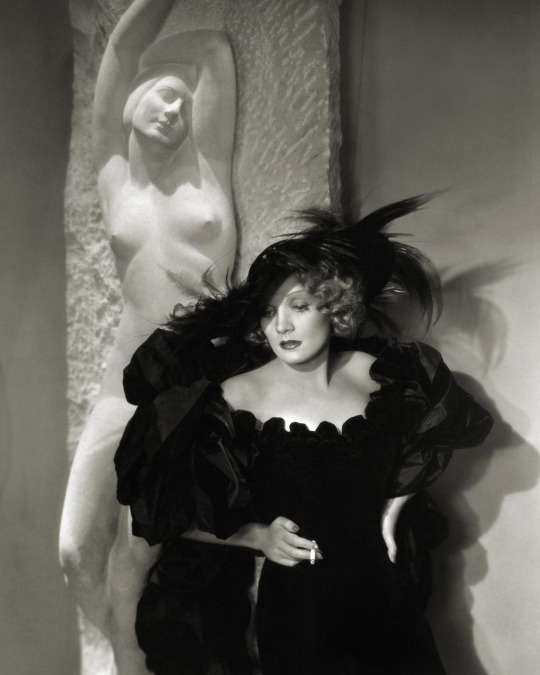
Raquel Stecher: In your book you discuss the attempts made to censor movies from state and federal government regulation to the creation of the MPPDA to the involvement of key figures like Joseph Breen and Will H. Hays. What is the biggest misconception about the Production Code?
Mark A. Vieira: There are a number of misconceptions. I label them and counter them: (1) “Silent films are not “pre-Code films.” (2) Not every pre-Code film was a low-budget shocker but made with integrity and artistry; most were big-budget star vehicles. (3) The pre-Code censorship agency was the SRC (Studio Relations Committee), part of the Motion Picture Producers and Distributors Association (MPPDA)—not the MPPA, which did not exist until the 1960s! (4) The Code did not mandate separate beds for married couples. (5) Joseph Breen was not a lifelong anti-Semite, second only to Hitler. He ended his long career with the respect and affection of his Jewish colleagues.
Raquel Stecher: How did the silent movie era and the Great Depression have an impact on the pre-Code era?
Mark A. Vieira: The silent era allowed the studios the freedom to show nudity and to write sexy intertitles, but the local censors cut those elements from release prints, costing the studios a lot of money, which in part led to the 1930 Code. The Great Depression emptied the theaters (or closed them), so producers used sexy films to lure filmgoers back to the theaters.
Raquel Stecher: TCM viewers love pre-Codes. What do you think it is about movies from several decades ago that still speak to contemporary audiences?
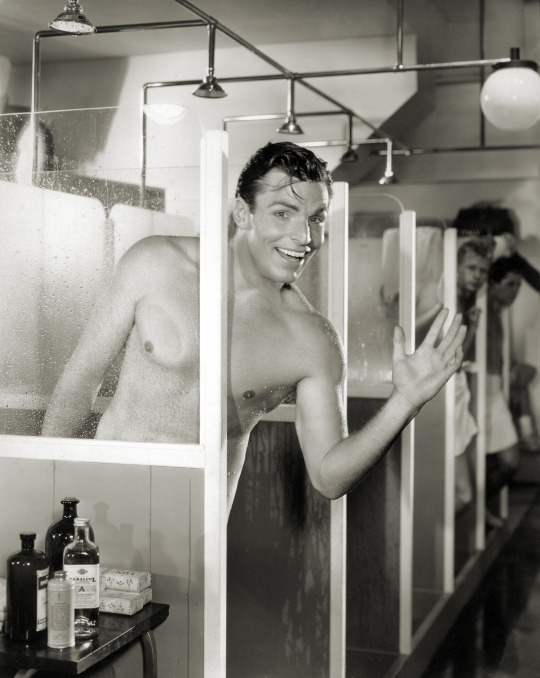
Mark A. Vieira: You’re right. Because we can see these films so readily, we forget that eight decades have passed since they premiered. We don’t listen to music of such a distant time, so how can we enjoy the art of a period in which community standards were so different from what they are now? After all, this was the tail end of the Victorian era, and the term “sex” was not used in polite society. How did it get into films like MIDNIGHT MARY (’33) and SEARCH FOR BEAUTY (’34)? There were protests against such films, and there were also millions of people enjoying them. What they enjoyed is what TCM viewers enjoy—frankness, honesty, risqué humor, beautiful bodies and adult-themed stories.
Raquel Stecher: What do you hope readers take away from your book?
Mark A. Vieira: One thing struck me as I wove the letters of just plain citizens into the tapestry of this story. Americans of the 1930s wrote articulate, heartfelt letters. One can only assume that these people were well educated and that they did a lot of reading—and letter writing. I want my readers to read the entire text of Forbidden Hollywood. I worked to make it accurate, suspenseful and funny. There are episodes in it that are hilarious. These people were witty! So I hope you’ll enjoy the pictures, but more so that you’ll dive into the story and let it carry you along. Here’s a quote about SO THIS IS AFRICA (‘33) from a theater owner: “I played it to adults only (over 15 years old). Kids who have been 12 for the last 10 years aged rapidly on their way to our box office.”
#pre-Code#TCM#Forbidden Hollywood#pre-code films#interview#jean harlow#mae west#ginger rogers#Depression era#1930s#Raquel Stecher
259 notes
·
View notes